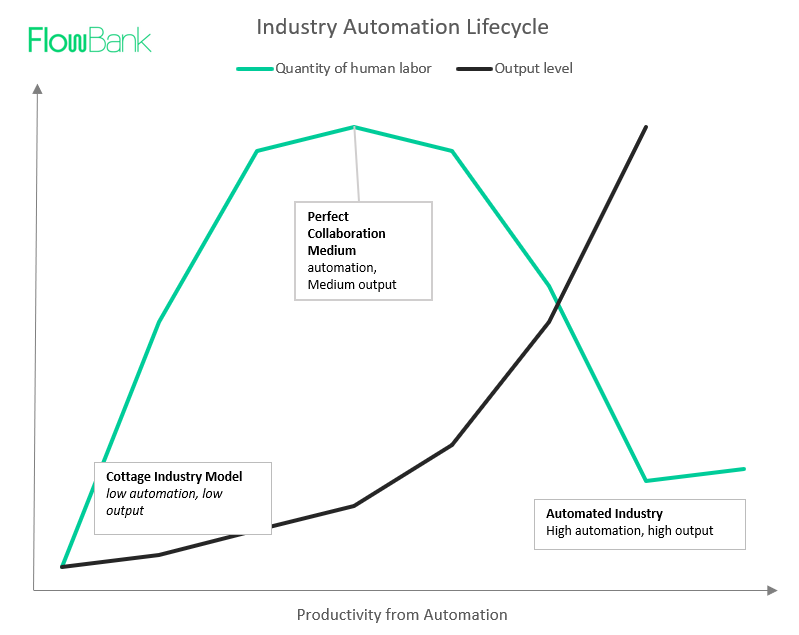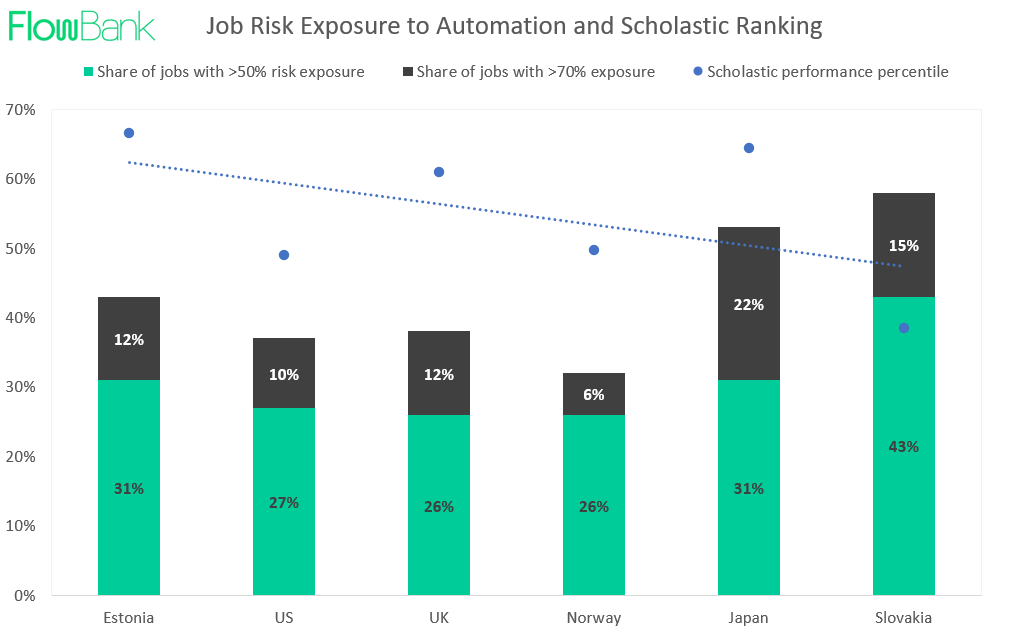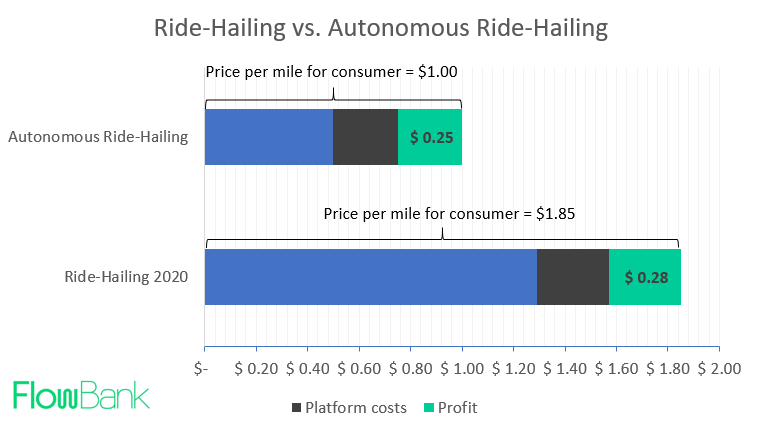Our take on the matter of Automation is that there is a misconception of machines evolving past humans instead of evolving with humans. Automation eliminating jobs is true, but it will also bolster the economy and generate better jobs and livelihoods.

Key Takeaways
- Automation is about combining RPA and IA to improve processes such as industrial production.
- Automation bleeds into labor market problems such as job loss but forecasts suggest more gains than losses from an improved worker productivity and positive externalities in job creation.
- Automation could create enough output surplus to increase social safety nets and increase wealth for more people.
- Automation will adversely affect capital intensive developing nations, and unskilled labor forces the most.
- Three myths about robots and automation: robots think like humans; robots will take our jobs; businesses need many robots to automate their business processes.
Introduction to automation
Automation is ultimately about artificial intelligence and robots coming together to create process efficiencies. There are two forms: Robot Process Automation (RPA) and Intelligent Automation (IA). Computers are becoming more powerful each year, and they are already better than humans at very specific programmable tasks such as chess. Fixed and repetitive processes seen in factory production for example, are targeted for full time automation and this has raised important questions around labor markets.
There are many concerns over the long-term impacts of machine automation replacing humans and while the truth is that many jobs will be replaced, many more could be generated. Automation will impact the way we do grocery shopping, the way we drive and the way we work. The question to ask yourself throughout this article is how is your long-term investment strategy successfully addressing impending structural changes?
Automation economics
Automation has and will continue to have a strong effect on labor and productivity. We begin with a conceptual framework of how labor and technological advancements intertwine. The first stage goes back in time to the age of textiles and mills otherwise known as the ‘’cottage industry’’. This industry format has very little to no automation and thus a large human involvement, and output levels are low. As the industry adds on more machines, and thus enables growth, the demand for human labor increases alongside it. Over time, more automation occurs, and as the output level continues to grow, the inverse is said of the quantity demanded for human involvement. The last piece of the puzzle is with regards to new output surplus-- where does it go? In this model, the surplus returns could (and ideally should) be reinvested in the cycle to push up demand for labor further upwards.

Automation need not be bad, even if some jobs are inevitably going to be replaced. An increased productivity can lead to an increasing level of well-being as more capital and wealth is accumulated through automation. In the U.S. private sector for example, there is a significant correlation between productivity and employment whereby one springs the other up. The inverse is seen however of U.S. Manufacturing, meaning that productivity increases will decrease demand for labor, but this ignores the offshoring of labor and can be discarded.
In the end, while there is a threat of replacement coming from automated labor, there is no certainty of a complete elimination. Automation can spur job creation faster than it eliminates them. Think of washing machines, which monetized unpaid time, ATMs which at the time increased teller jobs, or more recently food services who upon becoming automated opened up roles in deliveries, food prep, and cleanup. The fact is that automation can push humans to do more stimulating a detail oriented small scale tasks machines cannot.
It should be mentioned that different countries have different capital-labor divides, and that developing nations typically have more capital-intensive industries (think South Africa as seen in previous article, or China). On the other hand, developed nations are more reliant on labor intensive industries, hence their service led economies (think Sweden also a previous article, or the U.S.).
Research suggests that countries with lower scores in STEM (Science, Technology, Engineering and Mathematics) will be adversely affected by automation, because new jobs (those replacing labor intensive ones) will demand more highly skilled workers. Estonia, who places highest on the scholastic performance percentile ranking, will see 31% of jobs having a 50% exposure to automation risk, and 12% of jobs having a 70% exposure to automation risk. In other words, even countries whose population is already well positioned for STEM related work, will be adversely affected by automation depending on its labor-capital divide. While we know from economics that changes in the divide’s allocation do occur over time depending on tax rates, we still do not know the long-term labor and income effects that truly ensue from such changes.

What then becomes important is how do we make sure the output surplus is reinvested to create momentum for further employment? Suggestions revolve around two famous ideas: ‘’Robot Taxation’’ and ‘’Universal Basic Income’’. A robot tax could help build a better safety net by creating larger social security. If humans are taxed, why should not machines? If machines are owned by business owners however, are they classified as labor, or capital? If capital, then a tax equal to a capital gains tax could be put in place, benefiting both the owner and society. Universal Basic Income is also a solution, and while expensive it could protect those who lose jobs to automation. Perhaps a UBI program tailored to protect folks who can prove they lost work to robots would do the job well.
Autonomous driving
Automation is probably made most famous by self-driving technologies and autonomous vehicles. Robotaxis should no doubt expand the ride-hailing market to include self-driving vehicles. According to Ark Invest research, adjusted for inflation, the cost to own and operate a personal car has not changed since the Model T rolled out in the 30s. By 2025, the cost of autonomous taxis could change all that and crush the cost to one quarter dollar. The non-autonomous ride hailing market today generates $150 billion in revenues worldwide and the price per mile for consumers is $1.85 with profits made of $0.28 per mile. On the other side, autonomous ride-hailing would keep profit around the same levels ($0.25 per mile) while substantially decreasing the price consumers pay to about half or $1.00 per mile.

There are different strategies led by Tesla, Alphabet’s Waymo and Baidu’s Apollo that will drive the industry. Camera-based approaches like Tesla’s are more flexible and a much more scalable but a LiDar and HD mapping approach like Waymo’s is more perceiving but less go to market friendly. Chinese player Apollo develops infrastructure sensors which is the least flexible and scalable approach. The underlying and recurring question remains; who will lose out on this gain? Developing nations who rely more heavily on ride hailing will show more resistance and a slower growth. But then again, the same was said of a slow taxi industry to adapt to Uber’s innovation and now even the French allow Ubers in Paris
Myths about robots and AI
You need an army of robots to make robot process automation work. It is true that there is a minimum scale required to make both the return on the upfront investment in robots and the ongoing overhead of running them. It is also true that it is common for vendors to specify a minimum number of licenses to purchase, but in no way are those minimums too high or even prohibitive to running low scale automation processes. In other words, one can buy a minimum and see her return over time grow fat.
Robots will take all our jobs. Keynes, a famous economist, had predicted that the future would consist of high unemployment because of technological development. We showed above how this is already happening to an extent. However, looking at the previous 25 years, we have seen more jobs created than lost. Organizations that seek automation do not do so with the detriment of their workforce in mind, but rather the empowerment it can provide those responsible for production (workers). In the long run, one should see machines and humans working alongside in what is branded the Fourth Discontinuity by MIT Professor Bruce Mazlish in his work on the co-evolution of humans and machines.
Robots think like humans. Neither RPA nor IA replicate human reasoning exactly; robots mimic human behavior in the way they interact with application user interfaces, but they follow strict protocols different from ours. The moment is near, where robots could be indistinguishable from us, but it is unlikely in our lifetime, or ever. According to Robin Murphy’s ‘’Robotics through Science Fiction’’, in engineering, form follows function. In a world of automation, robots would not look or think like humans because of their inherently specialized functions to build, transport, or aid humans.
Some top robotics and automation companies to study further include:
Keyence develops and manufacturers automation sensors, vision systems, barcode readers, laser markers and more. The Japanese giant is fabrication-less meaning it specializes in product planning and does not manufacture final products.

Cadence makes software for designing and building circuits and electronic devices. Products include electronic design automation, and emulation hardware.

ABB engages in the development and provision of power an automation technologies. Operations include segments in electrification, industrial automation, robotics and discrete automation.

Brooks provides automation solutions for multiple markets such as semiconductor capital equipment, and management an storage of life science biological samples.

China-based company that provides automation control systems. It focuses on industrial automation, rail transportation, and mechanical solutions.

Rockwell provides industrial automation and digital transformation solutions. Its products include programmable automation controllers in design, visualization and simulation software.

Your can read more about Robotic trends and market size estimates in this article and about AI generally here. Also check out Apple's new robotaxi plans here.
Sources:
Ark Invest





